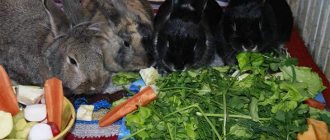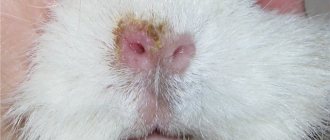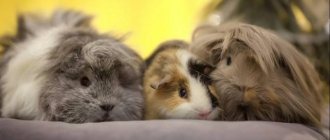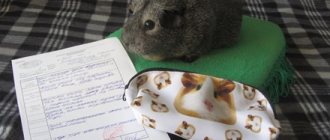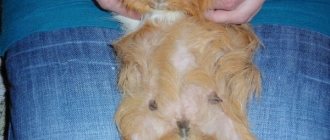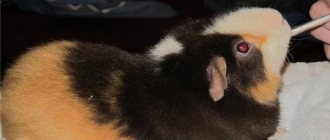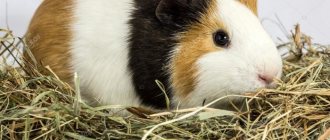- home
- Guinea pig
02/07/2019 Despite their name, guinea pigs are not considered the most water-consuming animals. Nevertheless, the owner should know why their animal suddenly begins to drink a lot, or refuses to drink at all. What is happening to them and why are they behaving this way?
Norm
About 250 ml is enough for one pet. Although, as a rule, there is no specific dose. Each animal consumes as much liquid as it needs, depending on its age and nutrition. The main thing is not to have enough.
You need to put a drinker in the cage, preferably a special ball or rod drinker, which differ in the type of valve. There is no difference, the first ones are just more popular. You should also pay attention to the fastenings. Plastic ones that are attached to the grille are the best option. There are also suction cups and wire ones. But they have their drawbacks: the first ones do not hold securely, while others create noise while drinking.
It is not recommended to simply pour water into a bowl. While running, an animal can easily turn it over, get wet and catch a cold.
Females who are expecting babies and nursing ones drink more than usual. Often leftover food gets into the water and it quickly spoils. Therefore, it must be changed daily. You can use filtered, still bottled water, but the temperature should be at room temperature. You can boil water, cool it to the required degrees and then pour it. Raw tap water, even settled water, is not suitable for drinking.
Some owners see that the animal does not seem to need it and stop giving water. But this cannot be done. All guinea pigs need to drink, some not enough, some more. A lack of fluid in the diet can lead to malfunctions of the pet’s internal organs.
Water norm
There is no exact norm for any living creature. There is only a recommended dosage. For guinea pigs, a quarter of a liter per day is enough. But for the most part, animals determine their own need for fluid. The amount of water drunk per day depends on the conditions of detention, age, physical activity, and nutrition. The main thing is that there is always water. The water must always be served clean and at room temperature to prevent it from catching a cold. Monitor how much water your guinea pig drinks per day. Based on these observations, it will be easier for you to regulate the water supply. Choose the right drinking bowl and place for it in the cage. Guinea pigs are quite active animals. While moving, they can spill water, get wet, and remain without a drink until you arrive. And if they get caught in a draft with wet fur, they can easily get sick. If you see that your pet rarely drinks water, then in any case change it with the same regularity. Remember that a lack of fluid in an animal has a very detrimental effect on it.
Why does my pig drink a lot of water?
Reasons why your guinea pig drinks a lot of water. It's possible she might have a fever. Another motive that causes thirst is that for a long time the food contains dry food: grain mixtures, hay, and there is little fresh grass and vegetables in the diet.
At home, especially in winter, when the air becomes dry due to heating, the animals' need to drink may increase.
It happens that a pig drinks water just to keep itself busy. In this case, you need to put the drinker only for a while.
Alternatively, the drinking bowl is leaking. Or if the cage is small, then the rodent can drink water out of nothing to do. This means that you need to change it to a more spacious one, check the sawdust under the drinker to see if it is wet. Sometimes the pig drinks carelessly, spilling some water.
Drinking too much can be caused by stress. If the pig has recently appeared in the apartment and the environment is new and unusual for it.
First aid and treatment
Urgently show the animal to the ratologist. It is necessary to quickly find out the cause and prescribe the correct treatment. There is not a doctor of this qualification in every city, and he does not always see you. The pet has at most 16 hours. Therefore, you need to be able to feed a guinea pig artificially. Force feeding begins when the hunger strike lasts more than 8 hours. There are several feeding options:
- Children's fruit or vegetable puree without prunes. The serving is 20% of the usual diet.
- Soaked food in grass granules.
- Wheat bran porridge or rolled oats with water are suitable.
- You can use baby porridge without milk.
- If the animal cannot take a bite, you need to grate vegetables, for example, pumpkin or carrots, on a fine grater.
The pet must be fed through an insulin syringe without a needle with a cut off tip. Thus, food will enter the intestines, albeit in a small dose. You can add a little ascorbic acid to increase the level of vitamin C in the body. Feeding should be done every 3 hours. Even if after a few days the guinea pig begins to eat on its own, take it to the doctor as soon as possible.
What to do
Drinking a lot is not harmful. Pigs differ from other rodents in that they drink large amounts of liquid and relieve themselves, especially if there is little succulent food. But it often happens that animals simply spill water - by accident or while running due to shaking, it spills itself. To prevent this from happening, you need to place a ceramic stand under the spout of the drinker, pour filler onto the bottom of the cage and cover it with sawdust.
And don’t worry about your pet drinking a lot. If the animal is healthy, it regulates its own drinking rate. More succulent food in the diet will reduce the dose consumed.
Source
Diagnostics
Don't hesitate if you see an animal acting strangely.
Take him to the veterinarian immediately - only he will be able to recognize the disease.
But, of course, you must be able to distinguish a sick rodent.
Diseases found in guinea pigs are divided into several types:
- defects caused by heredity;
- a number of parasitic diseases;
- diseases caused by improper feeding, as well as the composition of food feed;
- infections;
- all kinds of mechanical injuries.
How much water do you need?
How much water do you need? ¶
From: Mideya - December 18, 2004 5:10 am
I'm a little worried that my pig hardly drinks. maybe not drinking anything for a day. And I give him a little water-containing food (tomatoes, cucumbers). Basically he likes to beg for dill and lettuce in a pot. And recently I filled the feeder full with hay (before that there was just a wicker house made of hay). And he emptied it very quickly, and after that he drank the whole drinking bowl almost in one gulp and constantly runs up to drink again. This is fine? :confused:
How much water do you need? ¶
From: Jashka - December 18, 2004 5:22 am
Your task is to provide the pig with access to water and, of course, its constant availability in the drinking bowl. For the rest, the pig will figure out whether to drink it or not.
How much water do you need? ¶
From: Mideya - December 18, 2004 5:24 am
there is always water. but before she hardly drank, and now she doesn’t leave the drinking bowl. This seems strange to me.
How much water do you need? ¶
From: Jashka - December 18, 2004 5:28 am
Of course it's normal. I ate some dry hay and washed it down with some water! Mine do this too. This is especially noticeable after you put fresh hay in the hay barn. They overeat and then blow some water
How much water do you need? ¶
From: freckle - December 18, 2004 5:28
They have said more than once about drinking, if you give him cucumbers, tomatoes, apples, i.e. fruits and vegetables contain a lot of water, then your pig will drink little, but when you switch to dry food, then he will drink more. Although some Furmorians have pigs that drink little even when fed dry food. This apparently depends on the pig itself. [17 December 2004, 20:31: Message changed: freckle]
How much water do you need? ¶
From: _Natasha_ - February 27, 2006 4:42
My male (lives in a separate cage) doesn’t drink at all. But the females press in. They drink a decent portion of the drinker. Maybe the fact is that females have a drinking bowl with a wider spout (the metal part from where the water drips)? All my attempts to accustom him to drinking water were useless. Maybe he should not put any water in his cage then?
How much water do you need? ¶
From: KsyuKha - February 27, 2006 11:52
My male (lives in a separate cage) doesn’t drink at all. But the females press in. They drink a decent portion of the drinker. Maybe the fact is that females have a drinking bowl with a wider spout (the metal part from where the water drips)? All my attempts to accustom him to drinking water were useless. Maybe he should not put any water in his cage then? It’s better for him to also hang up a drinking bowl with a ball. And girls most likely don’t drink as much as they dig
How much water do you need? ¶
From: Poc - February 28, 2006 3:15 am
Believe it or not, my 4 pigs don't drink water at all! But they practically don’t eat dry food either. They mostly eat tomatoes and cucumbers, but when I give them apples and carrots, they get offended. And nothing, everyone is alive and well, the eldest is already 5 years old and has lived without water for all 5 years, although I tried for a long time to accustom her.
How much water do you need? ¶
From: _Natasha_ - February 28, 2006 7:33
KsyuKha, the male also has a drinking bowl, only there is a tube already there. And the females are so powerful. He ignores her.
How much water do you need? ¶
From: KsyuKha - February 28, 2006 15:15
KsyuKha, the male also has a drinking bowl, only there is a tube already there. And the females are so powerful. He ignores her. Then it means it's not attractive. When I took the pig into good hands, he was three years old. I ignored the drinking bowl. And after three months I discovered that I could drink from there!! I stood there all day enjoying it
How much water do you need? ¶
From: Marisha - February 28, 2006 5:16 pm
I'm a little worried that my pig hardly drinks. maybe not drinking anything for a day. And I give him a little water-containing food (tomatoes, cucumbers). Basically he likes to beg for dill and lettuce in a pot. And recently I filled the feeder full with hay (before that there was just a wicker house made of hay). And he emptied it very quickly, and after that he drank the whole drinking bowl almost in one gulp and constantly runs up to drink again. This is fine? :confused: Svetik, don’t worry, my little pigs don’t drink much either. The amount of moisture is compensated by the juicy food you give.
How much water do you need? ¶
Let the drinking bowl with water hang, and the pig will drink as much as it needs.
We make the drinker ourselves
If you don’t have extra funds or want to avoid low-quality hazardous materials, you can try making a drinking bowl yourself. To make a ball sippy cup, you will need:
- pen;
- plastic bottle;
- bearing (bicycle);
- sandpaper;
- silicone based sealant;
- stationery knife.
Step-by-step making of a ball drinker with your own hands:
1. It is necessary to disassemble the handle into its components - you will need its body. 2. Remove the ball from the bearing. 3. Next, you should place the ball in the body from the handle; it usually locks. Make a notch at this point; the unnecessary part needs to be cut off (you can use a hacksaw). 4. Blow into the handle, if there is an air passage, you need to remove excess parts, fixing the ball tightly. 5. Make a hole at the bottom of the plastic container to insert the pen body. 6. To avoid water leakage, apply sealant at the joint. 7. It is necessary to fix the former handle at an angle of 45 °, so the water will flow freely when acting on the ball.
The advantages of a home drinking bowl are that it is made with love for your pet and has a long service life. Disadvantages - not everyone can do this on their own; children will have to resort to the help of adults.
When is a Guinea Pig Not Drinking Water Normally?
The normal amount of water that a guinea pig should drink per day is approximately 200 ml. A standard drinking bowl should have a volume of at least 250 ml. Thanks to it, the pet will be able to independently distribute the amount of liquid throughout the day.
There are situations in which a guinea pig does not drink from the water bowl or drinks little, being absolutely healthy. Such situations occur quite often and can make the owner think that the pet is sick. In fact, an animal can be completely healthy and not drink water for completely different reasons.
The main reason is poor quality water. It may be dirty, stale, or have an unpleasant aftertaste. A dirty drinking bowl can also be the cause. Even if you pour clean water into it, your pet will not be able to drink from it.
Another reason why the guinea pig began to drink significantly less water is a change in diet:
- adding juicy fruits and vegetables to food; consumption of liquid food; moisture comes from grass and greenery; reducing the amount of food in the diet, dietary nutrition.
To make sure your guinea pig is healthy, you need to evaluate its daily diet and food quality. If they have not changed recently, the likely reason for refusing water is a disease of the internal organs.
Main diseases of guinea pigs and how to cope with them
Guinea pigs are charming and cute animals, which are often acquired when children, realizing that they cannot get a cat or dog, ask to take at least some animal. With proper care, pigs can live up to 10 years. Despite the fact that they seem like primitive and stupid animals, pigs turn into real family members. Pigs are quite unpretentious and easy to care for. But, like any animal, a guinea pig requires attention to its health, living conditions and can get sick. Timely identification of your pet's health problems and the correct response can speed up recovery, and in some cases, save the animal's life.
Norm
About 250 ml is enough for one pet. Although, as a rule, there is no specific dose. Each animal consumes as much liquid as it needs, depending on its age and nutrition. The main thing is not to have enough.
You need to put a drinker in the cage, preferably a special ball or rod drinker, which differ in the type of valve. There is no difference, the first ones are just more popular. You should also pay attention to the fastenings. Plastic ones that are attached to the grille are the best option. There are also suction cups and wire ones. But they have their drawbacks: the first ones do not hold securely, while others create noise while drinking.
It is not recommended to simply pour water into a bowl. While running, an animal can easily turn it over, get wet and catch a cold.
Females who are expecting babies and nursing ones drink more than usual. Often leftover food gets into the water and it quickly spoils. Therefore, it must be changed daily. You can use filtered, still bottled water, but the temperature should be at room temperature. You can boil water, cool it to the required degrees and then pour it. Raw tap water, even settled water, is not suitable for drinking.
Some owners see that the animal does not seem to need it and stop giving water. But this cannot be done. All guinea pigs need to drink, some not enough, some more. A lack of fluid in the diet can lead to malfunctions of the pet’s internal organs.
Liquid intake rate
Do not worry ahead of time, because increased thirst does not always mean the presence of a serious pathology in the cat’s body. Veterinarians do not have water consumption standards. Indicators depend on many factors - age, physiological state, climatic conditions, nutrition, etc.
The amount of moisture required for the body can be calculated approximately: 0.03 ml of liquid per 1 gram of cat’s body weight. Moreover, you need to count not only water, but also wet food, milk, broth, etc.
Veterinary experts say that each cat has its own water consumption rate. You can determine that she has enough fluid by the animal’s behavior. If the cat is cheerful and active, eats with appetite and does not lose weight, then everything is in order with his health.
Diseases accompanied by lack of thirst
A guinea pig refuses water only when there is an excess of fluid in its body. This situation is often observed due to edema. Diseases leading to edema in guinea pigs:
- kidney diseases, especially urolithiasis; cardiovascular diseases, previous heart attack; pulmonary edema due to pneumonia.
With these diseases, the guinea pig's defense mechanism turns on. The less water she drinks, the faster all the moisture will leave the body.
When your guinea pig does not drink water or go to the toilet, you may suspect urolithiasis. It is a metabolic disorder in the body, resulting in the formation of stones of various natures in the kidneys. In the future, these stones cause a number of symptoms:
- change in urination; pain syndrome; loss of appetite; vomit.
The main symptom is refusal of water. In the future, kidney stones can move along the ureter, thereby injuring it and clogging the lumen. A characteristic sign of a stone in the ureter is bloody urine. Before the stone passes from the kidney into the ureter, it can provoke an attack of renal colic.
If treatment is not carried out, the stone then moves down the ureter and enters the bladder. The guinea pig begins a period of imaginary well-being, as the stone simply floats in the bladder. Well-being continues until a stone blocks the outlet of the bladder. In this case, a clear clinical picture appears:
- the animal completely refuses water and stops going to the toilet; sharp, pronounced pain syndrome (the animal rushes about and cannot find a place for itself); enlargement of the abdomen due to stretching of the bladder; severe intoxication of the body (repeated vomiting, lethargy).
If you do not visit a veterinarian and do not begin urgent treatment, there is a risk of death.
Another disease in which a guinea pig does not drink water and is lethargic is a complication of myocardial infarction - heart failure. This disease occurs more often in adult animals. Heart failure is a consequence of untreated myocardial infarction or improper adherence to veterinarian prescriptions.
Main manifestations of heart failure:
- lethargy and apathy of the guinea pig, rare monotonous movements around the cage; swelling of the whole body, especially the abdomen and limbs; complete refusal of food and food; rare trips to the toilet; dry ears; deterioration of coat condition.
Fluffy doesn't drink, what should I do?
There are cases when an animal refuses water from ball drinkers; let’s look at the most common reasons for refusal:
- If a rodent previously used a drinking bowl and suddenly stopped, this may indicate a disease. Be sure to visit a veterinarian.
- No experience - if your pet has always drank from a bowl, he may simply not understand what to do with a new thing. But kids often imitate their elders and learn on their own.
- If you have replaced the home with a new one, the rodent will not immediately be able to detect the source of water, just point it in the right direction.
- If you are sure that the animal is healthy, but still refuses to drink, the quality of the water or the contamination of the bowl/drinker may be to blame. Try washing the device and changing the water. Guinea pigs normally consume about 200 ml of water.
There are times when a guinea pig does not drink and there is a loss of appetite, this mainly indicates that the animal is sick. A loving owner should not ignore these signals. Such periods may occur when the season changes: try to eliminate the blues on your own and boost your immunity by preparing a vitamin puree. Grind the lettuce, feed and add a little water. Feed the animal every 3-4 hours using a syringe. Give clean water after feeding.
Stress and lack of thirst
If your guinea pig is not drinking water and has lost weight, stress is a likely cause. This is especially true for animals that have just been purchased. A change of environment or moving to a new place of residence has a negative impact on the psychological state of the pet. He is nervous in anticipation of something new, which is a strong stress factor. In order to return the guinea pig’s psyche to normal, you should pay it as much attention as possible, try to cuddle it, and feed it something tasty. After a while, the pet will adapt and start drinking water.
If several guinea pigs lived in the same cage at the same time, the death of one of the neighbors could become a stress factor. Guinea pigs take loss hard, so during such periods they require increased attention.
Some other common stress factors for guinea pigs:
- constant loud noise around the cage (especially often observed in rooms where there are children); sudden change in climatic conditions; change of food or diet; pungent smell, light.
All these factors lead to the fact that the guinea pig may refuse water. To prevent this condition, it should be quiet near the cage with the guinea pig, there should be enough lighting, and there should be no strong odors. Your pet should be introduced to new foods gradually.
Possible diseases
In some cases, the reluctance to drink water is due to the fact that the guinea pig has excess fluid in its body, which leads to internal swelling. Typically this condition is a symptom of the following diseases:
- heart attack;
- urolithiasis disease;
- pneumonia;
- problems with blood vessels;
- renal failure.
With such ailments, the guinea pig’s body tries to get rid of the accumulated liquid in it, so the pet does not drink anything.
Important! If the rodent suddenly becomes lethargic and does not eat or drink anything, it is necessary to show it to a doctor as soon as possible, since without timely medical care the pig may die.
To reduce the likelihood of your pet developing various diseases, compliance with the care and maintenance conditions necessary for these rodents will help:
- A properly selected balanced diet.
- Avoiding stressful situations.
- Creating a comfortable environment in the cage.
- Maintaining physical activity.
- Creating a suitable climate in the room where the cage is located.
What to do
Drinking a lot is not harmful. Pigs differ from other rodents in that they drink large amounts of liquid and relieve themselves, especially if there is little succulent food. But it often happens that animals simply spill water - by accident or while running due to shaking, it spills itself. To prevent this from happening, you need to place a ceramic stand under the spout of the drinker, pour filler onto the bottom of the cage and cover it with sawdust.
And don’t worry about your pet drinking a lot. If the animal is healthy, it regulates its own drinking rate. More succulent food in the diet will reduce the dose consumed.
How much should you drink when sick?
Doctors often recommend drinking plenty of fluids while prescribing medication. But it is not always clear what is hidden under this concept. How much water should you drink to avoid fluid deficiency in the body? Physiological specialists have calculated how much a person with coronavirus infection needs to drink. According to research and calculations, on average, for every degree of temperature increase, it is necessary to increase the intake of liquid in the amount of 10 ml per kg of weight. Thus, if you have a high fever (approximately 39°C), you will need half a glass or a glass of water every hour.
Interesting! Japanese scientists studying coronavirus infection have concluded that you need to drink a few sips every 15 minutes. This helps to avoid drying out of the mucous membrane and reduces the risk of infection in the respiratory tract.
General feeding rules
The recommended daily ratio of all types of food looks like this:
- dry food – 5-10% (no more than a tablespoon); juicy food – 30%; hay – 60%.
If there is no dry food on the menu, an adult pig should eat approximately 150 g of vegetables per day . She is served vegetables every day, and is occasionally pampered with berries and fruits. Vegetable dishes must be supplemented with leafy greens, which compensate for the lack of vitamins.
Do not keep your rodent on a mono-diet, feeding it only carrots or beets: this will cause health problems. It’s great if there are different products on his table every day: parsley will be replaced by dill/basil, and celery by carrots/zucchini. A typical daily diet consists of three types of vegetables and herbs.
Important! Do not collect plants near highways, factories, or in swampy areas. Dry the grass for at least 1.5-2 months: it should not be blackened or rotten.
Do not forget to establish an uninterrupted supply of hay (especially during the cold period): the guinea pig chews it constantly, without limiting itself in volume. Hay normalizes digestion and is necessary for proper grinding of teeth.
Legume and legume-cereal hay is considered the most valuable. The rodent will also thank you for the vitamin herbs (nettle, alfalfa and clover) that you will prepare in the summer. These plants will be an excellent feed for growing and pregnant animals.
How many times a day should you feed your guinea pig?
She is fed two to three times, provided that hay, as well as bowls of food and water, are constantly present in the cage. If the pig does not immediately try the fresh portion, it will definitely finish it after some time.
Juicy food is given, as a rule, in the first half of the day, and in the second half the emphasis shifts to dry food . With three meals a day, the rodent is given 1/3 tablespoon of dry food at one time, with two meals a day - half a tablespoon.
Having eaten the main provisions, the pig switches to dry grass: not only can it not starve, but it should not. An empty stomach causes intestinal stagnation.
Important! European veterinarians resort to euthanizing a starving pig if more than 18 hours have passed since its last meal. It is believed that irreversible changes have occurred in the animal's body.
Drinking regime and nutrition
It is more convenient to feed a guinea pig with ready-made concentrated food, at the rate of 20 g per kilogram of animal weight. If you give crackers, white bread or crispbread as a treat, you should know that such food is part of the finished food. Therefore, it must be given in accordance with the permissible volume.
It is worth adding 50 grams of succulent feed and fresh hay to the finished concentrated mixture. This type of feeding allows you to maintain the pig’s health at a high level, since all food has a balanced composition and is rich in vitamins and minerals.
Water is of great importance for rodents. Therefore, it is worth washing the sippy cup every day and pouring fresh, clean water. As vitamins, you can add ascorbic acid to the sippy cup at the rate of 30 ml per 100 ml of liquid. Vitamin C solution can be obtained from a veterinary clinic or pharmacy.
Water parameters
To keep your guinea pig healthy, you need to ensure proper fluid status:
Temperature
The water should be at room temperature; using cold or ice water can cause diseases such as pneumonia.
Quality
The water must be filtered; using tap water is not advisable.
Replacement
Frequent replacement of water in the drinking bowl is necessary, from 1 to 3 times a day, in order to avoid the development of bacteria in stagnant water and their entry into the rodent’s body.
Treatment
Depending on the cause, treatment can be as simple as feeding the right foods, providing B vitamins (vitamin B complex at 20 ml/kg), or changing the environment to allow incompatible gilts to eat. Infectious diseases and dental problems will require immediate veterinary treatment. Subcutaneous injections will help restore water balance.
If the veterinarian determines that there is no bloating (gas) or intestinal obstruction, then hand feeding may support your guinea pig. Make sure to read the topic on syringe feeding.
Diazepam - (subcutaneous, intramuscular, or oral) is one of several drugs that can be used to stimulate appetite. Diazepam (also known as Valium) can cause appetite within a few minutes and will last up to half an hour, but also causes sedation and ataxia (loss of muscle coordination, especially in the limbs).
We suggest you read: Snake vision as reptiles see
Cyproheptadine - (Periactin 4mg - 1/8 tablet, twice daily) is used by some veterinarians to restore appetite.
What to feed your guinea pig at home
It is important to maintain a balance between a conservative diet and its diversity. Reckless experiments (sudden changes in food or poor quality food) can cause disruption in the gastrointestinal tract and lead to the death of the pet.
Supporters of traditional feeding are confident that the optimal daily menu for a pig should include carrots, apples, white cabbage (very little), high-quality granulated food, parsley/dill + a lot of hay.
During the summer/autumn season, they add carrot tops, cauliflower, zucchini, cucumber from their garden, as well as environmentally friendly dried grass picked outside the city.
Vegetables, fruits, greens
To ensure that all vitamins are widely represented in the daily diet, succulent food must be alternated: ideally, from 3 to 5 types of vegetables/fruits and herbs.
Vegetable assortment:
- carrots, beets (and their tops); zucchini and pumpkin; cauliflower and white cabbage (in small doses); Bulgarian pepper; rutabaga and turnip; green peas (in pods); cucumber and tomato (preferably from your own garden).
Important! The latter vegetables are rarely given: cucumbers “wash out” calcium in large quantities, and store-bought tomatoes can be oversaturated with pesticides.
Assorted fruits and berries:
- apples, including dried ones; pears (very few - they are hard on the stomach); citrus fruits – rarely and little by little; berries (any, but infrequently).
The same list includes apricots, peaches, nectarines, plums and cherries, but with a limitation in quantity: these fruits contain a lot of sugars, and market fruits also contain chemicals.
Leafy greens such as watercress, head lettuce (without the base and core), Beijing lettuce (with the removal of the lower part that accumulates nitrates) and leaf lettuce itself (leaves without petioles) are allowed.
Also recommended:
- dill and parsley; greens of sprouted cereals (including oats and wheat); celery; leaves of garden and forest strawberries; currant, raspberry and mint leaves; plantain, dandelions, gooseberry, clover and other grass.
Do not forget to thoroughly wash everything picked in the forest and in the country.
Grains, nuts in feed
Pigs are herbivores, not granivores, which is why pelleted/grain mixtures cannot be the mainstay of their diet . The granules usually contain a lot of calcium and proteins, which contribute to the deposition of stones in the bladder and cause other ailments of the kidneys and liver.
What not to feed guinea pigs
The list of prohibited products is extensive.
It included:
- potatoes and cereals (in any form); dairy products, including cow's butter, cottage cheese and cream; pickles and smoked meats; winter cucumbers, tomatoes and watermelons; confectionery products, including chocolate and marshmallows; meat, fish and eggs; burdock, spinach and sorrel; green onions and salad mustard; mushrooms, chestnuts and any inflorescences; garlic, horseradish and radish; table salt, sugar and sweet tea; bakery and pasta products.
It is not recommended to give guinea pigs branches of certain trees: buckthorn, oak, rowan, larch, hornbeam, elm, willow, spruce and pine. But since you can’t do without wood, feel free to include shoots of apple, plum, hazel, currant, cherry, hawthorn, apricot, gooseberry (without thorns), pear and blueberry in your diet.
Characteristics of a guinea pig: advantages and disadvantages
| How long does a guinea pig live? | On average from 5 to 8 years. There are long-livers who live up to 15 years. But this is very rare. Lifespan depends on housing conditions and nutrition. |
| Is it possible to teach a rodent different tricks? | The ability to train is there, but it is difficult to teach. You can teach simple tricks: spin around your axis, stand on your hind legs to beg for food, etc. |
| What size should a guinea pig cage be? | The animal needs a spacious cage or terrarium. The minimum cage floor size for keeping one individual is 30x60 cm. The larger the territory, the more comfortable the kevi live. |
| What does a guinea pig get sick with? | The most common diseases:
|
| What is the price of the animal? | From 500 to 10 thousand rubles, depending on the breed. The most expensive are the hairless Guinea pigs - Skinny (from $80), Baldwin (from $120). |
| Does pig stink? | With proper care, your pet will not smell. |
| What should you not feed this animal? |
|
| What is the best way to transport caves? | A special plastic container, terrarium or regular carrier for cats or small breed dogs will do. In cold weather, it is necessary to insulate the carrier with a heating pad with warm but not hot water, a layer of hay or an old woolen item. |
| Which drinking bowl and feeder is better to buy? | There should be two feeders - for green food and for dry food. Choose stable bowls, preferably ceramic ones, so that the animal cannot turn them over. Vertical nipple drinkers are very convenient for small rodents. The volume of the drinking bowl is at least 250 ml per individual. It is better to use filtered or special bottled water. It must be changed daily, even if the pet does not have time to drink everything. |
| Which litter to choose for your pet? | The best option is granulated or regular sawdust, poured onto the bottom of the cage in an even layer of 4–6 cm. The filler is replaced weekly. You can buy it at a pet store or make it yourself. Granular filler absorbs better than regular sawdust. |
| Does a rodent need vaccinations? | No, pigs are not vaccinated. They are given prophylaxis against external and internal parasites. |
| How to choose the right guinea pig? | It is necessary to choose a moderately well-fed individual with shiny fur and eyes, with a good appetite, at the age of 4 - 5 weeks. The rodent should not have bald spots, scabs or peeling skin, dirty or matted hair in the anal area, or discharge from the eyes or nose. When the pig is picked up, it should not struggle or squeal. It is better to purchase a pet from a breeder with a good reputation. |
Pros of keeping caves:
- Ideal pets for children, do not take up much space.
- They quickly get used to a nickname or conventional call (whistle).
- Non-aggressive (biting individuals are almost never found).
- Indifferent towards other animals.
- They are unpretentious in food, do not need walks and physical activity.
- They are considered the most hypoallergenic pet.
Difficulties of maintenance and care:
- They are difficult to train, but some tricks can be taught.
- They can be intrusive - they beg for food and affection.
- Noisy - they make many different sounds: whistling, squealing, squeaking, grumbling, grunting (each sound has its own meaning).
- They are very active, so they scatter hay, droppings and sawdust around the cage.
- They chew furniture, wires and other things.
- While walking outside the cage, they may relieve themselves on the carpet or floor.
- They mark their territory with urine and secretions from their glands.
- They are afraid of cold and overheating and catch cold easily.
- They do not tolerate loneliness well, so a companion is required.
- They are shy, so they take a long time to get used to people.
